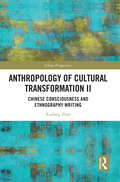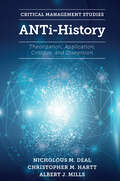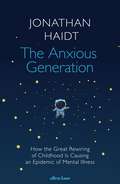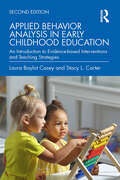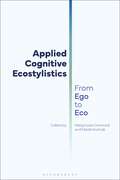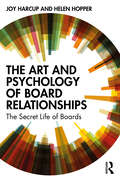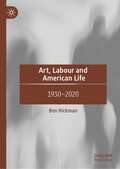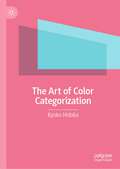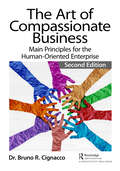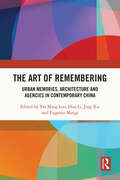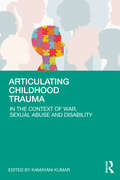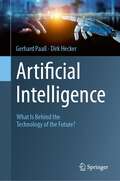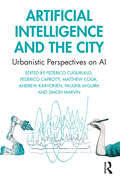- Table View
- List View
Anthropology of Cultural Transformation II: Chinese Consciousness and Ethnography Writing (ISSN)
by Xudong ZhaoThis book is the second of a two-volume set on the anthropology of cultural transformation. It examines how cultural consciousness enriches and reshapes the vision of anthropology and ethnographic writing.Anthropology in the twenty-first century is confronted with a worldview of cultural transformation based on communication, collision, and interaction among cultures around the globe. This two-volume set aims to reorient the role and function of anthropology by focusing on reconstructing knowledge and cultural consciousness to better imagine and realize the synergetic interaction between different cultures and civilizations. The second volume begins with a case study of the demolition of urban areas in Beijing, revealing a reinvention of public cultural representation. It then explores the new paths and missions of Chinese anthropological studies and ethnographic writing, which should be grounded in China's indigenous consciousness and cultural reservoir.The title will appeal to anthropologists, students, and general readers interested in anthropology, sociology, and ethnography.
Anthropology of Cultural Transformation II: Chinese Consciousness and Ethnography Writing (ISSN)
by Xudong ZhaoThis book is the second of a two-volume set on the anthropology of cultural transformation. It examines how cultural consciousness enriches and reshapes the vision of anthropology and ethnographic writing.Anthropology in the twenty-first century is confronted with a worldview of cultural transformation based on communication, collision, and interaction among cultures around the globe. This two-volume set aims to reorient the role and function of anthropology by focusing on reconstructing knowledge and cultural consciousness to better imagine and realize the synergetic interaction between different cultures and civilizations. The second volume begins with a case study of the demolition of urban areas in Beijing, revealing a reinvention of public cultural representation. It then explores the new paths and missions of Chinese anthropological studies and ethnographic writing, which should be grounded in China's indigenous consciousness and cultural reservoir.The title will appeal to anthropologists, students, and general readers interested in anthropology, sociology, and ethnography.
ANTi-History: Theorization, Application, Critique and Dispersion (Critical Management Studies)
by Nicholous M. Deal Christopher M. Hartt Albert J. MillsThere has been a surge of ANTi-History research over the last 15 years. ANTi-History brings together the most impactful efforts to develop, apply and critique ANTi-History in one comprehensive book. Deal, Hartt and Mills make sense of and organize the ongoing conversation around ANTi-History, using it as a lens to assess both the future and the potential of the budding field of historical organization studies and business history. They offer a systematic close reading of ANTi-History through its introduction to the field nearly two decades ago; the literatures that theorize it as an approach for ‘doing history’ and how others have contributed to its usefulness to scholars, practitioners, and students. In addition, they offer an exploration of the empirical research areas, settings, and contexts – especially its position within an archival zeitgeist in critical management studies – that scholars have engaged in; and the international character that it has taken across numerous countries around the world. ANTi-History revisits the debates that concern ANTi-History and its theorization of the past, identifying potential future research and unique opportunities to further advance and refine ANTi-History and critical historiography scholarship.
ANTi-History: Theorization, Application, Critique and Dispersion (Critical Management Studies)
by Nicholous M. Deal Christopher M. Hartt Albert J. MillsThere has been a surge of ANTi-History research over the last 15 years. ANTi-History brings together the most impactful efforts to develop, apply and critique ANTi-History in one comprehensive book. Deal, Hartt and Mills make sense of and organize the ongoing conversation around ANTi-History, using it as a lens to assess both the future and the potential of the budding field of historical organization studies and business history. They offer a systematic close reading of ANTi-History through its introduction to the field nearly two decades ago; the literatures that theorize it as an approach for ‘doing history’ and how others have contributed to its usefulness to scholars, practitioners, and students. In addition, they offer an exploration of the empirical research areas, settings, and contexts – especially its position within an archival zeitgeist in critical management studies – that scholars have engaged in; and the international character that it has taken across numerous countries around the world. ANTi-History revisits the debates that concern ANTi-History and its theorization of the past, identifying potential future research and unique opportunities to further advance and refine ANTi-History and critical historiography scholarship.
The Anxious Generation: How the Great Rewiring of Childhood Is Causing an Epidemic of Mental Illness
by Jonathan Haidt‘Jonathan Haidt is a modern-day prophet, disguised as a psychologist . . . He points the way forward to a brighter, stronger future for us all’ Susan Cain'Compelling, readable, remarkably persuasive' Telegraph'Urgent and essential . . . it ought to become a foundational text for the growing movement' GuardianFrom the international bestselling author of The Righteous Mind and The Coddling of the American MindAfter more than a decade of stability or improvement, the mental health of adolescents in many countries around the world deteriorated suddenly in the early 2010s. Why have rates of depression, anxiety, self-harm and suicide risen so sharply, more than doubling in many cases?In this book, Social Psychologist Jonathan Haidt argues that the decline of free-play in childhood and the rise of smartphone usage among adolescents are the twin sources of increased mental distress among teenagers.Haidt delves into the latest psychological and biological research to show how, between 2010 and 2015, childhood and adolescence got rewired. As teens traded in their flip phones for smartphones packed with social media apps, time online soared while time engaging face-to-face with friends and family plummeted, and so did mental health. This profound shift took place against a backdrop of diminishing childhood freedom, as parents over-supervised every aspect of their children’s lives offline, depriving them of the experiences they most need to become strong and self-governing adults.The Anxious Generation reveals the fundamental ways in which this shift from free-play to smartphones disrupts development – from sleep deprivation to addiction – with separate in-depth analyses of the impact on girls and boys. Grounded in ancient wisdom and packed full of cutting-edge science, this eye-opening book is a life raft and a powerful call-to-arms, offering practical advice for parents, schools, governments, and teens themselves.
Applied Behavior Analysis in Early Childhood Education: An Introduction to Evidence-based Interventions and Teaching Strategies
by Laura Baylot Casey Stacy L. CarterApplied Behavior Analysis in Early Childhood Education provides a basic introduction to applied behavior analysis and overviews the highly beneficial role that it can play in early childhood education for both typically developing children and those with special needs. This updated text equips future and current early childhood professionals with the tools they need to positively impact the lives of young children, including how to implement effective techniques for changing behavior, strategies for everyday challenges both in the classroom and at home, and suggestions for how to consult and correspond with parents and caretakers. The book is ideal for professionals preparing for—or those already in—careers in child development, behavior analysis, early childhood education, developmental therapy, counseling, and special education. A companion website provides further information and resources for students and instructors.
Applied Behavior Analysis in Early Childhood Education: An Introduction to Evidence-based Interventions and Teaching Strategies
by Laura Baylot Casey Stacy L. CarterApplied Behavior Analysis in Early Childhood Education provides a basic introduction to applied behavior analysis and overviews the highly beneficial role that it can play in early childhood education for both typically developing children and those with special needs. This updated text equips future and current early childhood professionals with the tools they need to positively impact the lives of young children, including how to implement effective techniques for changing behavior, strategies for everyday challenges both in the classroom and at home, and suggestions for how to consult and correspond with parents and caretakers. The book is ideal for professionals preparing for—or those already in—careers in child development, behavior analysis, early childhood education, developmental therapy, counseling, and special education. A companion website provides further information and resources for students and instructors.
Applied Cognitive Ecostylistics: From Ego to Eco
by Malgorzata Drewniok, Marek Kuźniak, andThis book offers an up-to-date account of one of the most influential strands of eco-research: cognitive ecostylistics. The onset of the 1970s saw a global shift in scholarly perspective upon the relation between egocentric and ecocentric views of the world. The so-called eco-turn was not only linguistic at its roots, but engaged the bulk of academic thought in social sciences and humanities. Cognitive ecostylistics invites a multidisciplinary approach to the study of the conceptual relations between oral or written texts and their impact on the environment. This volume is a collection of the latest research that seeks to apply the theory and methodology developed over the last 40 years to both literary and real-life texts, engaging with a wealth of examples from First World War poetry and Anne of Green Gables through to Condé Nast Traveller hotel descriptions. Exploring the cultural effects of the eco-turn, the collection engages the reader in the problem of the present-day Anthropocene, manifested as Ego-Eco tensions at the level of communicating self-needs and the needs of the Other. Divided into two parts, it considers first the human-angled semiotic interplay contained within the universe of people, before examining the problem of semiotic engagement of texts as extraneous to the human, highlighting crucial aspects of nature, culture, and beyond.
Arbeits- und Organisationspsychologie: Eine Einführung – kompakt, prägnant und anwendungsorientiert (Angewandte Psychologie Kompakt)
by Peter Michael BakDieses prägnante Lehrbuch aus der Lehrbuchreihe Angewandte Psychologie kompakt enthält die wichtigsten psychologischen Theorien und Konzepte rund um die Themen der Arbeits- und Organisationspsychologie. Es ist speziell für Studierende konzipiert, die sich einen schnellen und eingängigen Überblick über die Thematik sowie einen starken Praxisbezug wünschen.Die sorgfältige Didaktik, Klausurfragen, digitale Zusatzmaterialien und Zusammenfassungen stellen eine optimale Grundlage für das Verstehen des Lehrstoffes und die Prüfungsvorbereitung im Bereich der Arbeits- und Organisationspsychologie dar.Durch zahlreiche Anwendungsbeispiele, Reflexionsfragen, eingebundene Audioclips und Online-Zusatzmaterialien ist es in einzigartiger Weise anwendungsorientiert und weckt dadurch Lust, das Gelernte gedanklich weiterzuentwickeln und in verschiedensten Kontexten umzusetzen.Zusätzlich sind Fragen und Antworten zum Selbsttest über die SN Flashcards Lern-App inkludiert. Der Zugangscode befindet sich im gedruckten Buch.Die ZielgruppenStudierende sowie Lehrende der Psychologie und angrenzender Disziplinen, die Grundlegendes in kompakter, übersichtlicher und praxisnaher Form verstehen und anwenden wollen.
An Architecture of Place: Topology in Practice
by Randall S. LindstromChallenging mainstream architecture’s understandings of place, this book offers an illuminating clarification that allows the idea’s centrality, in all aspects of everyday design thinking, to be rediscovered or considered for the first time.Rigorous but not dense, practical but not trivialising, the book unfolds on three fronts. First, it clearly frames the pertinent aspects of topology—the philosophy of place—importantly differentiating two concepts that architecture regularly conflates: place and space. Second, it rejects the ubiquitous notion that architecture “makes place” and, instead, reasons that place is what makes architecture and the built environment possible; that place “calls” for and to architecture; and that architecture is thus invited to “listen” and respond. Finally, it turns to the matter of designing responses that result not just in more places of architecture (demanding little of design), nor merely in architecture with some “sense of place” (demanding little more), but, rising above those, responses that constitute an architecture of place (demanding the greatest vigilance but offering the utmost freedom).Opening up a term regarded as so common that its meaning is seldom considered, the author reveals the actual depth and richness of place, its innateness to architecture, and its essentiality to practitioners, clients, educators, and students—including those in all spatial disciplines.
An Architecture of Place: Topology in Practice
by Randall S. LindstromChallenging mainstream architecture’s understandings of place, this book offers an illuminating clarification that allows the idea’s centrality, in all aspects of everyday design thinking, to be rediscovered or considered for the first time.Rigorous but not dense, practical but not trivialising, the book unfolds on three fronts. First, it clearly frames the pertinent aspects of topology—the philosophy of place—importantly differentiating two concepts that architecture regularly conflates: place and space. Second, it rejects the ubiquitous notion that architecture “makes place” and, instead, reasons that place is what makes architecture and the built environment possible; that place “calls” for and to architecture; and that architecture is thus invited to “listen” and respond. Finally, it turns to the matter of designing responses that result not just in more places of architecture (demanding little of design), nor merely in architecture with some “sense of place” (demanding little more), but, rising above those, responses that constitute an architecture of place (demanding the greatest vigilance but offering the utmost freedom).Opening up a term regarded as so common that its meaning is seldom considered, the author reveals the actual depth and richness of place, its innateness to architecture, and its essentiality to practitioners, clients, educators, and students—including those in all spatial disciplines.
The Art and Psychology of Board Relationships: The Secret Life of Boards
by Joy Harcup Helen HopperThe relationships within boards can make or break an organisation, but well-functioning relationships take skill and effort to maintain. This book looks at the psychology behind individual and group behaviour and offers tactics and power tools to help make a success of your board career. The book shares advice and practical tips from 40 experienced board members from the worlds of corporates, the public sector and charities on how to spot and manage complex dynamics. And each chapter ends with techniques for unlocking tricky board relationships that you can put into practice immediately. The authors examine case studies and explore topics such as psychodynamics, cognitive behavioural psychology and neuroscience for insights into how boards react under pressure. They then demonstrate how to practise the ART of managing board relationships by increasing Awareness, Relating constructively to others, and choosing Tactics to ease tensions and foster collaboration. The Art and Psychology of Board Relationships: The Secret Life of Boards reveals why board relationships lie at the heart of organisational success – and how you can use them to gain competitive edge. It is essential reading for current and aspiring board members, coaches, facilitators and anyone with an interest in boardroom dynamics.
The Art and Psychology of Board Relationships: The Secret Life of Boards
by Joy Harcup Helen HopperThe relationships within boards can make or break an organisation, but well-functioning relationships take skill and effort to maintain. This book looks at the psychology behind individual and group behaviour and offers tactics and power tools to help make a success of your board career. The book shares advice and practical tips from 40 experienced board members from the worlds of corporates, the public sector and charities on how to spot and manage complex dynamics. And each chapter ends with techniques for unlocking tricky board relationships that you can put into practice immediately. The authors examine case studies and explore topics such as psychodynamics, cognitive behavioural psychology and neuroscience for insights into how boards react under pressure. They then demonstrate how to practise the ART of managing board relationships by increasing Awareness, Relating constructively to others, and choosing Tactics to ease tensions and foster collaboration. The Art and Psychology of Board Relationships: The Secret Life of Boards reveals why board relationships lie at the heart of organisational success – and how you can use them to gain competitive edge. It is essential reading for current and aspiring board members, coaches, facilitators and anyone with an interest in boardroom dynamics.
The Art and Science of Connection: Why Social Health is the Missing Key to Living Longer, Healthier, and Happier
by Kasley KillamA groundbreaking redefinition of what it means to be healthy that introduces the need for social health - the part of wellbeing that comes from feeling connected - to truly flourish.Exercise. Eat a balanced diet. Go to therapy. Most wellness advice is focused on achieving and maintaining good physical and mental health. But Harvard-trained social scientist and pioneering social health expert Kasley Killam reveals that this approach is missing a vital component: human connection.Relationships not only make us happier, but also are critical to our overall health and longevity. Research shows that people with a strong sense of belonging are 2.6 times more likely to report good or excellent health. Perhaps even more astonishingly, people who lack social support are up to 53% more likely to die from any cause. Yet social health has been overlooked and underappreciated - until now.Just as we exercise our physical muscles, we can strengthen our social muscles. Weaving together cutting-edge science, mindset shifts, and practical wisdom, Killam offers the first methodology for how to be socially healthy. An antidote to the loneliness epidemic and an inspiring manifesto for seeing wellbeing as not only physical and mental, but also social, The Art and Science of Connection is a handbook for thriving.In this essential book, you will:- Learn a simple yet powerful framework to understand, evaluate, and bolster your social health.- Discover the exact strategy or habit you need, as well as research-backed tips, to cultivate and sustain meaningful connection now and throughout your life.- Glean actionable insights to develop a sense of community in your neighbourhood, at work, and online from a spirited group of neighbours in Paris, the CEO of a major healthcare company, and an artificially intelligent chatbot.- Get an insider look at the innovative ways that doctors, teachers, entrepreneurs, architects, government leaders, and everyday people are catalysing a movement toward a more socially healthy society.The Art and Science of Connection will transform the way you think about each interaction with a friend, family member, coworker, or neighbour, and give you the tools you need to live a more connected and healthy life - whether you are an introvert or extrovert, if you feel stretched thin, and no matter your age or background. Along the way, Killam will reveal how a university student, a newlywed, a working professional, and a retired widow overcame challenges to thrive through connection-and how you can, too.
Art, Labour and American Life: 1930–2020
by Ben HickmanThis book examines labour in the age of US hegemony through the art that has grappled with it; and, vice versa, developments in American culture as they have been shaped by work’s transformations over the last century. Describing the complex relations between cultural forms and the work practices, Art, Labour and American Life explores everything from Fordism to feminization, from whitecollar ascendency to zero hours precarity, as these things have manifested in painting, performance art, poetry, fiction, philosophy and music. Labour, all but invisible in cultural histories of the period, despite the fact most Americans have spent most of their lives doing it, here receives an urgent re-emphasis, as we witness work’s radical redefinition across the world.
The Art of Color Categorization
by Kyoko HidakaFrom Newton's prism spectroscopy to modern color science, the study of color has been rooted in the categorization of colors. Building upon this foundation, this book aims to explore the rich and varied examples of color theory through two basic concepts: categorizing colors themselves and categorizing things by color. How have different cultures drawn the line between colors, and why? What do these divisions reveal about color naming, standards, environments, and sensory perceptions? The book delves into these questions, shedding light on how color categorization has shaped our world. Through this exploration of color theory, the author also hopes to draw attention to the potential parallels between Western color classifications and the logic of racism. By examining various theories on color classification standards, the author seeks to unravel this complex issue and encourage readers to reflect on how our understanding of color and categorization can impact our social and cultural attitudes.
The Art of Compassionate Business: Main Principles for the Human-Oriented Enterprise
by Bruno R. CignaccoThere are several well-ingrained assumptions regarding the dynamics of work and business activities, which can be refuted. Some examples of these widespread assumptions in business and work environments are employees being viewed as commodities, competitors perceived as threats, companies’ resources seen as limited, and customers perceived as scarce and difficult. All this leads to the question: "Is there a way to perform business activities more humanely?" The second edition of this book challenges the reader to change the way they perform in business situations and become more focused on the human aspects of business activities. The users of this knowledge and those affected by them will undergo a profound transformation in the way they perform business activities. They will benefit from gradually testing and implementing the guidelines conveyed in this book, both in the business environment and in the workplace. When readers put these principles into practice, positive ripple effects are bound to affect other stakeholders of the organisation they work for or own. The author has refreshed all the concepts and examples introduced in the first edition which include aspects related to mission and vision, passion, business mindset, organisational learning, improvement of business conversations, use of constructive criticism, and betterment of relationships with the most relevant stakeholders (customers, suppliers, intermediaries, community, employees, etc.). The author also includes a discussion of creativity and the innovation process as well as other relevant aspects related to a healthy business environment and provides various real-life examples of companies which have adopted a loving attitude towards their stakeholders – which has become so important in the current business environment.
The Art of Compassionate Business: Main Principles for the Human-Oriented Enterprise
by Bruno R. CignaccoThere are several well-ingrained assumptions regarding the dynamics of work and business activities, which can be refuted. Some examples of these widespread assumptions in business and work environments are employees being viewed as commodities, competitors perceived as threats, companies’ resources seen as limited, and customers perceived as scarce and difficult. All this leads to the question: "Is there a way to perform business activities more humanely?" The second edition of this book challenges the reader to change the way they perform in business situations and become more focused on the human aspects of business activities. The users of this knowledge and those affected by them will undergo a profound transformation in the way they perform business activities. They will benefit from gradually testing and implementing the guidelines conveyed in this book, both in the business environment and in the workplace. When readers put these principles into practice, positive ripple effects are bound to affect other stakeholders of the organisation they work for or own. The author has refreshed all the concepts and examples introduced in the first edition which include aspects related to mission and vision, passion, business mindset, organisational learning, improvement of business conversations, use of constructive criticism, and betterment of relationships with the most relevant stakeholders (customers, suppliers, intermediaries, community, employees, etc.). The author also includes a discussion of creativity and the innovation process as well as other relevant aspects related to a healthy business environment and provides various real-life examples of companies which have adopted a loving attitude towards their stakeholders – which has become so important in the current business environment.
The Art of Remembering: Urban Memories, Architecture and Agencies in Contemporary China
by Hua Li Jing Xie Yat Ming Loo Eugenio MangiFocusing on the non-Western context and case studies, this book explores theories of interdisciplinary architectural thinking and the construction of urban memory in Chinese cities, with an emphasis on contemporary architecture and the diversity of agencies.China has undergone one of the fastest urbanisation and urban renewal processes in human history, but discussions of urban memory in China have tended to be practice-oriented and lack theoretical reflection. This book brings together interdisciplinary architectural scholarship to interrogate the production of urban memory and examine experiences in China. The 14 chapters explore different processes, projects, materials, architecture and urban spaces in different Chinese cities by analysing cityscapes such as temples, bridges, conservation projects, architectural design, historical architecture, memorial hall, market street, city images, custom bike, food market and so on. The book deals with different agencies and methods, tangible and intangible, in the construction of memories aimed at promoting hybridised multiple identities, and explores the interplay of different versions of memory, i.e. state, public, regional, local, individual and collective memory.This book will be essential reading for scholars and students of architecture and urbanism, cultural studies and China studies, as well as architects, urban planners and historians interested in these fields.
The Art of Remembering: Urban Memories, Architecture and Agencies in Contemporary China
by Hua Li Jing Xie Yat Ming Loo Eugenio MangiFocusing on the non-Western context and case studies, this book explores theories of interdisciplinary architectural thinking and the construction of urban memory in Chinese cities, with an emphasis on contemporary architecture and the diversity of agencies.China has undergone one of the fastest urbanisation and urban renewal processes in human history, but discussions of urban memory in China have tended to be practice-oriented and lack theoretical reflection. This book brings together interdisciplinary architectural scholarship to interrogate the production of urban memory and examine experiences in China. The 14 chapters explore different processes, projects, materials, architecture and urban spaces in different Chinese cities by analysing cityscapes such as temples, bridges, conservation projects, architectural design, historical architecture, memorial hall, market street, city images, custom bike, food market and so on. The book deals with different agencies and methods, tangible and intangible, in the construction of memories aimed at promoting hybridised multiple identities, and explores the interplay of different versions of memory, i.e. state, public, regional, local, individual and collective memory.This book will be essential reading for scholars and students of architecture and urbanism, cultural studies and China studies, as well as architects, urban planners and historians interested in these fields.
Articulating Childhood Trauma: In the Context of War, Sexual Abuse and Disability
The volume addresses the pertinent need to examine childhood trauma revolving around themes of war, sexual abuse, and disability. Drawing narratives from spatial, temporal, and cultural contexts, the book analyses how conflict, abuse, domestic violence, contours of gender construction, and narratives of ableism affect a child’s transactions with society. While exploring complex manifestations of children’s experience of trauma, the volume seeks to understand the issues related to translatability/representation, of trauma bearing in mind the fact that children often lack the language to express their sense of loss. The book in its study of childhood trauma does a close exegesis of select literary pieces, drawings done by children, memoirs, and graphic narratives.Academicians and research scholars from the disciplines of childhood studies, trauma studies, resilience studies, visual studies, gender studies, cultural studies, disability studies, and film studies stand to benefit from this volume. The ideas that have been expressed in this volume will richly contribute towards further research and scholarship in this domain.
Articulating Childhood Trauma: In the Context of War, Sexual Abuse and Disability
by Kamayani KumarThe volume addresses the pertinent need to examine childhood trauma revolving around themes of war, sexual abuse, and disability. Drawing narratives from spatial, temporal, and cultural contexts, the book analyses how conflict, abuse, domestic violence, contours of gender construction, and narratives of ableism affect a child’s transactions with society. While exploring complex manifestations of children’s experience of trauma, the volume seeks to understand the issues related to translatability/representation, of trauma bearing in mind the fact that children often lack the language to express their sense of loss. The book in its study of childhood trauma does a close exegesis of select literary pieces, drawings done by children, memoirs, and graphic narratives.Academicians and research scholars from the disciplines of childhood studies, trauma studies, resilience studies, visual studies, gender studies, cultural studies, disability studies, and film studies stand to benefit from this volume. The ideas that have been expressed in this volume will richly contribute towards further research and scholarship in this domain.
Artificial Intelligence: What Is Behind the Technology of the Future?
by Gerhard Paaß Dirk HeckerArtificial Intelligence (AI) is already present in our daily routines, and in the future, we will encounter it in almost every aspect of life – from analyzing X-rays for medical diagnosis, driving autonomous cars, maintaining complex machinery, to drafting essays on environmental problems and drawing imaginative pictures. The potentials of AI are enormous, while at the same time many myths, uncertainties and challenges circulate that need to be tackled. The English translation of the book “Künstliche Intelligenz – Was steckt hinter der Technologie der Zukunft?” originally published in German (Springer Vieweg, 2020), this book is addressed to the general public, from interested citizens to corporate executives who want to develop a better and deeper understanding of AI technologies and assess their consequences. Mathematical basics, terminology, and methods are explained in understandable language. Adaptations to different media such as images, text, and speech and the corresponding generative models are introduced. A concluding discussion of opportunities and challenges helps readers evaluate new developments, demystify them, and assess their relevance for the future.
Artificial Intelligence and the City: Urbanistic Perspectives on AI
This book explores in theory and practice how artificial intelligence (AI) intersects with and alters the city. Drawing upon a range of urban disciplines and case studies, the chapters reveal the multitude of repercussions that AI is having on urban society, urban infrastructure, urban governance, urban planning and urban sustainability. Contributors also examine how the city, far from being a passive recipient of new technologies, is influencing and reframing AI through subtle processes of co-constitution. The book advances three main contributions and arguments: First, it provides empirical evidence of the emergence of a post-smart trajectory for cities in which new material and decision-making capabilities are being assembled through multiple AIs. Second, it stresses the importance of understanding the mutually constitutive relations between the new experiences enabled by AI technology and the urban context. Third, it engages with the concepts required to clarify the opaque relations that exist between AI and the city, as well as how to make sense of these relations from a theoretical perspective. Artificial Intelligence and the City offers a state-of-the-art analysis and review of AI urbanism, from its roots to its global emergence. It cuts across several disciplines and will be a useful resource for undergraduates and postgraduates in the fields of urban studies, urban planning, geography, architecture, urban design, science and technology studies, sociology and politics.
Artificial Intelligence and the City: Urbanistic Perspectives on AI
by Federico Cugurullo Federico Caprotti Matthew Cook Andrew Karvonen Pauline McGuirk Simon MarvinThis book explores in theory and practice how artificial intelligence (AI) intersects with and alters the city. Drawing upon a range of urban disciplines and case studies, the chapters reveal the multitude of repercussions that AI is having on urban society, urban infrastructure, urban governance, urban planning and urban sustainability. Contributors also examine how the city, far from being a passive recipient of new technologies, is influencing and reframing AI through subtle processes of co-constitution. The book advances three main contributions and arguments: First, it provides empirical evidence of the emergence of a post-smart trajectory for cities in which new material and decision-making capabilities are being assembled through multiple AIs. Second, it stresses the importance of understanding the mutually constitutive relations between the new experiences enabled by AI technology and the urban context. Third, it engages with the concepts required to clarify the opaque relations that exist between AI and the city, as well as how to make sense of these relations from a theoretical perspective. Artificial Intelligence and the City offers a state-of-the-art analysis and review of AI urbanism, from its roots to its global emergence. It cuts across several disciplines and will be a useful resource for undergraduates and postgraduates in the fields of urban studies, urban planning, geography, architecture, urban design, science and technology studies, sociology and politics.
